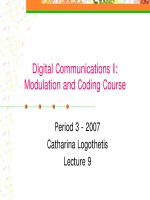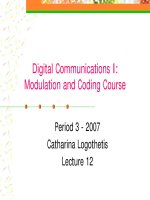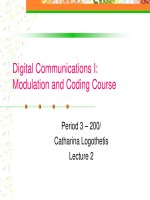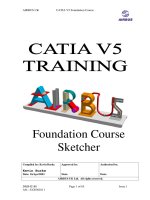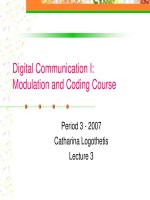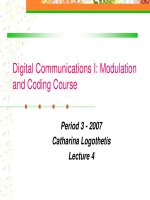Modulation and coding course- lecture 9
Bạn đang xem bản rút gọn của tài liệu. Xem và tải ngay bản đầy đủ của tài liệu tại đây (202.8 KB, 43 trang )
Digital Communications I:
Modulation and Coding Course
Period 3 - 2007
Catharina Logothetis
Lecture 9
Lecture 9 2
Last time we talked about:
Evaluating the average probability of
symbol error for different bandpass
modulation schemes
Comparing different modulation schemes
based on their error performances.
Lecture 9 3
Today, we are going to talk about:
Channel coding
Linear block codes
The error detection and correction capability
Encoding and decoding
Hamming codes
Cyclic codes
Lecture 9 4
Block diagram of a DCS
Format
Source
encode
Format
Source
decode
Channel
encode
Pulse
modulate
Bandpass
modulate
Channel
decode
Demod.
Sample
Detect
Channel
Digital modulation
Digital demodulation
Lecture 9 5
Channel coding:
Transforming signals to improve
communications performance by increasing
the robustness against channel impairments
(noise, interference, fading, ..)
Waveform coding: Transforming waveforms to
better
waveforms
Structured sequences: Transforming data
sequences into better
sequences, having
structured redundancy.
-“Better” in the sense of making the decision process less
subject to errors.
What is channel coding?
Lecture 9 6
Error control techniques
Automatic Repeat reQuest (ARQ)
Full-duplex connection, error detection codes
The receiver sends a feedback to the transmitter,
saying that if any error is detected in the received
packet or not (Not-Acknowledgement (NACK) and
Acknowledgement (ACK), respectively).
The transmitter retransmits the previously sent
packet if it receives NACK.
Forward Error Correction (FEC)
Simplex connection, error correction codes
The receiver tries to correct some errors
Hybrid ARQ (ARQ+FEC)
Full-duplex, error detection and correction codes
Lecture 9 7
Why using error correction coding?
Error performance vs. bandwidth
Power vs. bandwidth
Data rate vs. bandwidth
Capacity vs. bandwidth
(dB) /
0
NE
b
B
P
A
F
B
D
C
E
Uncoded
Coded
Coding gain:
For a given bit-error probability,
the reduction in the Eb/N0 that can be
realized through the use of code:
[dB][dB] [dB]
c
0
u
0
⎟
⎟
⎠
⎞
⎜
⎜
⎝
⎛
−
⎟
⎟
⎠
⎞
⎜
⎜
⎝
⎛
=
N
E
N
E
G
bb
Lecture 9 8
Channel models
Discrete memory-less channels
Discrete input, discrete output
Binary Symmetric channels
Binary input, binary output
Gaussian channels
Discrete input, continuous output
Lecture 9 9
Linear block codes
Let us review some basic definitions first
which are useful in understanding Linear
block codes.
Lecture 9 10
Some definitions
Binary field :
The set {0,1}, under modulo 2 binary
addition and multiplication forms a field.
Binary field is also called Galois field, GF(2).
011
101
110
000
=⊕
=⊕
=⊕
=⊕
111
001
010
000
=⋅
=⋅
=⋅
=⋅
Addition
Multiplication
Lecture 9 11
Some definitions…
Fields :
Let F be a set of objects on which two
operations ‘+’ and ‘.’ are defined.
F is said to be a field if and only if
1. F forms a commutative group under + operation.
The additive identity element is labeled “0”.
1. F-{0} forms a commutative group under .
Operation. The multiplicative identity element is
labeled “1”.
1. The operations “+” and “.” distribute:
FabbaFba ∈+=+⇒∈∀ ,
FabbaFba
∈⋅=⋅⇒∈∀ ,
)()()( cabacba ⋅+⋅=+⋅
Lecture 9 12
Some definitions…
Vector space:
Let V be a set of vectors and F a fields of
elements called scalars. V forms a vector space
over F if:
1.
Commutative:
2.
3.
Distributive:
1.
Associative:
2.
VuvVv ∈=⋅⇒∈∀∈∀ aFa ,
vuvuvvv ⋅+⋅=+⋅⋅+⋅=⋅+ aaababa )( and )(
FV ∈+=+⇒∈∀ uvvuvu,
)()(,, vvv ⋅⋅=⋅⋅⇒∈∀∈∀ babaVFba
vvVv =⋅∈∀ 1 ,
Lecture 9 13
Some definitions…
Examples of vector spaces
The set of binary n-tuples, denoted by
Vector subspace:
A subset S of the vector space is called a
subspace if:
The all-zero vector is in S.
The sum of any two vectors in S is also in S.
Example:
. of subspace a is )}1111(),1010(),0101(),0000{(
4
V
n
V
n
V
)}1111(),1101(),1100(),1011(),1010(),1001(),1000(
),0111(),0101(),0100(),0011(),0010(),0001(),0000{(
4
=V
Lecture 9 14
Some definitions…
Spanning set:
A collection of vectors ,
the linear combinations of which include all vectors in
a vector space V, is said to be a spanning set
for V or
to span V.
Example:
Bases:
A spanning set for V that has minimal cardinality is
called a basis for V.
Cardinality of a set is the number of objects in the set.
Example:
{}
.for basis a is )0001(),0010(),0100(),1000(
4
V
{}
. spans )1001(),0011(),1100(),0110(),1000(
4
V
{ }
n
G vvv ,,,
21
K
=
Lecture 9 15
Linear block codes
Linear block code (n,k)
A set with cardinality is called a
linear block code if, and only if, it is a
subspace of the vector space .
Members of C are called code-words.
The all-zero codeword is a codeword.
Any linear combination of code-words is a
codeword.
n
V
n
VC ⊂
k
2
nk
VCV ⊂→
Lecture 9 16
Linear block codes – cont’d
n
V
k
V
C
Bases of C
mapping
Lecture 9 17
Linear block codes – cont’d
The information bit stream is chopped into blocks of k bits.
Each block is encoded to a larger block of n bits.
The coded bits are modulated and sent over channel.
The reverse procedure is done at the receiver.
Data block
Channel
encoder
Codeword
k bits n bits
rate Code
bits Redundant
n
k
R
n-
k
c
=


